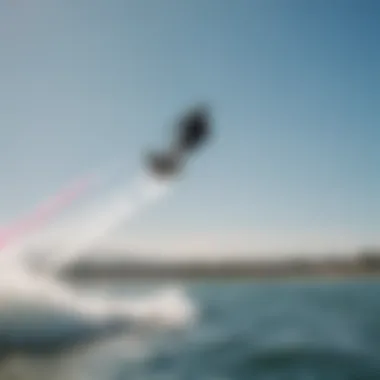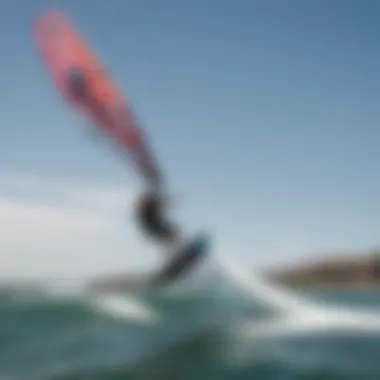Exploring the Lyft Hydrofoil in Kiteboarding


Intro
Kiteboarding has always been about pushing boundaries, blending thrill with skill. Among the latest innovations in this domain is the Lyft hydrofoil, a game changer for enthusiasts. This new equipment opens doors to unique experiences, allowing riders to glide above the water's surface with minimal drag. The essence of the hydrofoil is not just in its design but in how it transforms what kiteboarding can be.
Imagine carving through the waves with a sense of elevation, where the board lifts you above the turbulent sea below. The Lyft hydrofoil makes this possible, appealing to anyone from beginners to seasoned veterans of the sport. Yet, delving deeper, it’s not simply about enjoying a new ride; it also sheds light on the nuances of technique, maintenance, and the gear required. Through this article, we will explore various aspects, examining what makes this equipment tick and how it can elevate your kiteboarding journey.
As we turn our focus to equipment insights, we will look closely at the latest gear reviews and essential maintenance tips to keep your hydrofoil in top shape. Armed with this information, riders can navigate the waters with confidence and finesse.
Prolusion to Hydrofoils
Understanding hydrofoils is crucial for appreciating the advancements in kiteboarding brought forth by the Lyft Hydrofoil. Hydrofoils transform the way riders interact with water, permitting them to glide above the surface, which greatly influences speed, efficiency, and maneuverability. As kiteboarding enthusiasts seek to elevate their riding experience, hydrofoils play a pivotal role in this evolution.
What is a Hydrofoil?
A hydrofoil is a specialized structure attached beneath a kiteboard that lifts the board out of the water as the rider gains speed. It operates on the principle of hydrodynamics, where the foil generates lift through water flow, allowing the rider to skim across the surface without much drag. The reduced water contact results in a smoother ride and increased speeds, making for a more exhilarating experience. Essentially, it’s like flying, but over water. Riders who have experienced hydrofoiling often describe it as riding on a magic carpet, where water conditions are rendered negligible.
Key components of a hydrofoil generally include:
- The Wing: The main part that creates lift, often shaped like an airplane wing.
- The Mast: This connects the wing to the board, acting as a vertical support.
- The Board: Where the rider stands, typically narrower than traditional boards to accommodate the hydrofoil setup.
History of Hydrofoil Development
The development of hydrofoils can be traced back to the early 1900s, when innovators like Alexander Graham Bell and his team experimented with hydrofoil designs for aircraft. However, it wasn’t until the late 20th century that hydrofoiling began to attract attention in sports like sailing and kiteboarding.
In the early days, hydrofoils were mostly used in racing yachts, enhancing their speed and efficiency. As kiteboarding gained popularity in the 1990s, forward-thinking designers started bridging these two worlds. Notable milestones include:
- 1970s: Early hydrofoil designs emerged in the surfing and sailing communities.
- 1990s: The first kiteboarding hydrofoils debuted, revolutionizing the sport by allowing riders to achieve unprecedented speeds and fluid movement.
- 2000s: Advancements in materials and manufacturing processes led to more accessible, lighter, and stronger hydrofoils for the average rider.
Today, companies like Lyft are at the forefront, continually pushing the boundaries of what is possible in hydrofoil technology. The Lyft Hydrofoil, in particular, encapsulates the evolution of this technology, making it a significant contributor to kiteboarding's ongoing revolution.
Understanding the Lyft Hydrofoil
Understanding the Lyft Hydrofoil is crucial for anyone looking to enhance their kiteboarding experience. With the advancements in technology, the Lyft Hydrofoil stands out as a significant innovation in the kiteboarding world. The design and engineering behind this equipment not only affects performance but also redefines what riders can achieve on the water. It brings a sense of weightlessness that has transformed how many approach the sport.
To appreciate the Lyft Hydrofoil fully, one must consider its unique features and the engineering marvel that it embodies. By delving into its design elements and the materials utilized in its construction, kiteboarders can recognize not just the mechanics but also the artistry involved. This understanding illuminates the advantages it offers over traditional kiteboarding setups, especially in terms of speed, stability, and maneuverability.
Design Features of the Lyft Hydrofoil
The design of the Lyft Hydrofoil is engineered for optimal performance and user experience. Each element serves a specific function—from the shape of the wings to the overall structure. The wings are crafted to generate lift efficiently, allowing the board to glide above the water’s surface. This lifts the rider out of the choppy waters, enabling smoother rides even in less-than-ideal conditions.
The sleek profile helps minimize drag, which is essential for achieving high speeds. The fuselage connects the wings and the board, carefully designed to ensure stability during turns and maneuvers. It’s the meticulous attention to detail in the drivetrain and the balance points that permit a higher level of control.
Additionally, the overall aesthetic is cutting-edge. With vibrant colors and modern lines, the design appeals not only to performance but also to the rider's sense of style. The versatility in the setup of the foil makes it adaptable for varying wind conditions and personal riding styles, ensuring that both beginners and seasoned pros find their sweet spot.
Materials Used in Construction
When it comes to construction, the Lyft Hydrofoil employs advanced materials that contribute to its lightweight and durability. Carbon fiber is predominantly used, which offers the perfect blend of strength and minimal weight. This material is ideal for those who want to experience the highest speeds without the burden of heavy gear. The use of aluminum in some components balances weight with robustness and ensures the foil can withstand the rigors of frequent use.
It’s not just about being lightweight; the oxygen seawater resistant coatings play a vital role in the longevity of the foil. Regular water exposure can corrode lesser materials, but the craftsmanship in Lyft Hydrofoils addresses this concern, ensuring that riders can focus more on their performance and less on maintenance.


"The right materials can mean the difference between having a good day on the water and enjoying an incredible one."
The combination of these elements points to a deep understanding of both the kiteboarding discipline and the rider's needs. Familiarity with the materials can lead to better care practices, enhancing the lifespan and performance of the equipment. For those invested in elevating their kiteboarding game, recognizing how the Lyft Hydrofoil operates on a mechanical and material level opens new avenues of understanding and appreciation.
Performance Characteristics
Understanding the performance characteristics of the Lyft Hydrofoil is crucial for appreciating how this innovative equipment enhances the kiteboarding experience. When examining performance factors, we’re not merely tossing around buzzwords; we’re talking about elements that can significantly change a rider's interaction with the water. Riders seek not just speed, but also a harmonious feel as they navigate swells, and that’s where the real story lies.
Speed and Maneuverability
Speed in kiteboarding often equates to freedom—the feeling of gliding effortlessly over the waves. The Lyft Hydrofoil caters to this desire by offering unparalleled speed. The design allows riders to achieve higher velocities than traditional boards due to its hydrodynamic shape. The wings don’t just slice through the water; they lift the board above the surface, reducing drag and allowing for faster accelerations.
Moreover, maneuverability is equally impressive. With the hydrofoil, turning sharply or altering directions mid-ride becomes a breeze. Riders can perform quick transitions, enhancing their ability to adapt to varying wind and water conditions. This capabilty of quick responsiveness is vital, especially when navigating crowded scenes or wave patterns that can change in an instant.
"The Lyft Hydrofoil takes kiteboarding to a whole new level, transforming everyday rides into top-speed adventures. Each shift in weight changes the momentum, allowing for intuitive maneuvers that feel natural."
Stability in Different Conditions
Next up, let's delve into stability—a key aspect riders often overlook. Stability plays a critical role whether you're facing gentle breezes or choppy waters. The Lyft Hydrofoil shines in both scenarios thanks to its thoughtful engineering. Riders often find it steadier than traditional boards, which can be a game-changer, especially for novices still mastering their balance.
With its ability to maintain an upright position during turbulence, the Lyft Hydrofoil helps to build confidence among users. Beginners can focus more on honing their skills rather than worrying about falling off every time a gust of wind whips their direction. For experienced riders, this stability can translate into even more daring tricks, knowing they have a reliable board underneath them.
To summarize, when it comes to performance characteristics, the Lyft Hydrofoil ticks all the boxes: it is fast, responsive, and stable across a spectrum of conditions. These features not only elevate the riding experience but also encourage exploration of new techniques and tricks, igniting a profound love for the sport.
Comparison with Traditional Kiteboarding
The evolution of kiteboarding has seen significant changes over the years, and the introduction of hydrofoils represents one of the most pivotal advancements. Understanding the contrast between hydrofoil boards and traditional setups is essential for enthusiasts looking to enhance their kiteboarding experience. The comparison highlights not only the technical benefits of hydrofoils but also the changing dynamics of how the sport is approached by both newcomers and seasoned riders.
Hydrofoil vs. Twin-Tip Boards
When pitting the hydrofoil against the classic twin-tip boards, several factors come into play that can sway a rider's decision.
- Lift and Speed: Hydrofoils stand out due to their ability to lift off the water, reducing drag. This means when a rider engages the hydrofoil correctly, they can achieve higher speeds with less effort. In contrast, twin-tip boards often require more power from the kite to maintain speed and direction. An experienced rider can feel confident in leveraging the new sensation of flying above the water.
- Smoothness of Ride: Going over choppy water can be jarring on a twin-tip. The hydrofoil glides smoothly, offering a more stable ride even in less than ideal conditions. Riders often describe riding with a hydrofoil as floating, akin to a bird soaring effortlessly in the sky.
- Learning Curve: Although hydrofoils provide a unique experience, they also come with a steeper learning curve. Newbies may find it challenging to adapt as balance and weight shifts become crucial. On the other hand, twin-tip boards are generally considered more user-friendly for beginners.
"Riding a hydrofoil for the first time felt like taking flight! But, mastering that balance took some getting used to."
— Ari, experienced kiteboarder
- Versatility: Twin-tip boards offer versatility; they can be ridden in both directions without needing to change the stance. Hydrofoils, while innovative, may have limitations in varied conditions but shine in flat water and steady winds, making the right conditions vital for a steller experience.
Advantages and Disadvantages
The conversation about hydrofoils wouldn't be complete without examining their pros and cons when stacked against traditional kiteboarding gear. Both options have valid points for consideration.
Advantages of Hydrofoils:
- Improved Speed: With the ability to reduce drag, hydrofoils allow riders to achieve notable speeds.
- Less Resistance: Riders experience less resistance when moving, meaning less fatigue during long rides.
- Unique Riding Experience: Surfing above the waves can provide breathtaking views and sensations like nothing else in the sport.
Disadvantages of Hydrofoils:
- Complexity in Learning: New riders may find the learning curve to be steep compared to traditional boards. The nuances of balancing and steering can intimidate the uninitiated.
- Cost Factor: Hydrofoils often come at a premium price compared to traditional boards, which might deter budget-conscious buyers.
- Limited Conditions: The performance can be hampered in heavy winds or rough waters, leading to a somewhat restricted riding experience.


As riders weigh these characteristics, a clearer picture emerges of how and when to incorporate hydrofoils into their kiteboarding repertoire. Understanding these strengths and weaknesses will help both new and experienced riders make informed decisions about their gear and riding style.
Target Audience and Skill Levels
Understanding the target audience and their skill levels is crucial for appreciating the Lyft Hydrofoil's role in kiteboarding. Different riders bring distinct experiences to the water, influencing how they interact with this innovative equipment. Whether a newcomer or a seasoned expert, grasping the nuances of these varying skill levels can inform better equipment choices and enhance the overall experience on the waves.
Beginner Suitability
The Lyft Hydrofoil holds particular appeal for beginners venturing into the kiteboarding scene. Its design and performance characteristics align well with what new riders seek. For those just learning to kiteboard, stability is everything, and the hydrofoil provides a unique edge with its lifted position above the water.
- Ease of Learning: Thanks to the hydrofoil’s ability to glide smoothly above the surface, beginners often experience less drag and more straightforward control. This helps in developing a feel for the kite without getting bogged down by typical board behavior in the water.
- Confidence Boost: For many new kiteboarders, the initial learning phase can be intimidating. With the lift provided by the hydrofoil, beginners can progress more confidently, reducing the frequency and intensity of falls. It’s not uncommon for first-timers to be pleasantly surprised by how quickly they attain a sense of balance.
- Accessibility: One notable aspect is the versatility of conditions suitable for learning. Unlike traditional boards, which demand a bit more wind or calmer waters, the Lyft Hydrofoil can perform admirably even in suboptimal conditions. This enables beginners to practice more often, leading to quicker advances in skill.
Advanced Techniques for Experienced Riders
For those with more experience, the Lyft Hydrofoil opens up a new frontier of kiteboarding possibilities. Advanced riders can leverage the hydrofoil’s unique features to push their skillsets to new heights.
- Complex Maneuvers: Experienced kiteboarders can enjoy executing sharp turns and surf-style maneuvers that traditional boards make challenging. The lift generated allows for more aggressive carving without the danger of clashing with choppy water, fostering creativity in their riding style.
- Increased Speed: Skilled riders can harness the hydrofoil’s aerodynamic qualities to attain remarkable speeds. Higher velocity can emerge from small tweaks in technique, delivering thrilling sensations on the water while also challenging the rider to refine their control.
- Tricks and Jumps: With practice, jumping and performing tricks on a hydrofoil opens up myriad aerial possibilities. The new dynamics experienced during take-off and landing often results in a heightened sense of freedom, showcasing riders’ talents in dazzling ways.
As one dives deeper into the sport, the conversation about learning, sustaining techniques, and mastering the lift under varied conditions becomes vital. The Lyft Hydrofoil, while presenting a different riding experience, enriches both beginner and advanced riders' paths, offering unique growth opportunities in the art of kiteboarding.
Maintenance and Care for Lyft Hydrofoils
Maintaining a Lyft hydrofoil is not merely a chore but an essential aspect to prolong its life and enhance the performance of this revolutionary kiteboarding equipment. Much like a well-tuned engine, a hydrofoil requires attention and care to function optimally. Neglecting it can lead to performance issues, unexpected malfunctions, or even safety hazards. With the growing popularity of hydrofoiling, understanding the nuances of upkeep is vital not just for the longevity of the equipment, but also for a safe and thrilling experience on the water. Here, we will delve into the regular maintenance practices and the proper storage considerations to ensure your Lyft hydrofoil remains in peak condition.
Regular Maintenance Practices
To keep your Lyft hydrofoil in tip-top shape, consistent maintenance is essential. Here are some key practices to consider:
- Rinse After Use: Saltwater can be particularly harsh on the materials. Rinsing the hydrofoil with fresh water after every use removes salt and debris that might cause corrosion or buildup.
- Inspect for Damage: Regularly examine the wings, mast, and fuselage for any signs of cracks or wear. Minor damage can escalate quickly, so it’s best to address these issues early on.
- Tighten Bolts and Screws: The components of the hydrofoil can loosen with use. Periodic checks and tightening of screws and bolts can prevent parts from falling apart mid-ride.
- Lubricate Moving Parts: If your hydrofoil boasts any moving parts, a little lubrication can go a long way in maintaining smooth operation. Use a suitable lubricant to reduce friction and wear.
- Follow Manufacturer Recommendations: Every model has its specific care requirements, so familiarize yourself with any instructions provided by the manufacturer to ensure compliance with their guidelines.
"Proper maintenance is like good schooling for your gear; it helps avoid future headaches!"
Keeping your hydrofoil clean and in working order not only enhances performance but also enhances your overall experience, providing smoother rides and better control.
Storage Considerations
Storing your Lyft hydrofoil correctly is as crucial as regular maintenance. Proper storage prevents damage and maintains the integrity of the materials. Here are important storage strategies:
- Dry Storage Area: Always store your hydrofoil in a dry place to prevent moisture buildup, which can lead to mold and degradation of materials.
- Avoid Sun Exposure: Prolonged exposure to sunlight can weaken the structural integrity of the hydrofoil. Using a bag or cover can help shield it from harmful UV rays.
- Disassemble When Possible: If your hydrofoil can be disassembled, it’s beneficial to do so for storage. This practice reduces strain on the components and saves space.
- Keep Away from Heavy Objects: Store your hydrofoil away from heavy items that could crush or warp its structure. A soft surface or padded bag works best.
- Check Before Riding: Before hitting the water after a period of storage, conduct a thorough check to ensure no issues have arisen during its downtime.
By prioritizing maintenance and careful storage practices, you not only prolong the life of your Lyft hydrofoil but also enhance your kiteboarding experience, ensuring that each ride is as exhilarating as the last.
Community Feedback and Perception
Community feedback and perception play a crucial role in the ongoing evolution of the Lyft hydrofoil within the kiteboarding realm. Understanding how users, from seasoned kiteboarders to enthusiastic newcomers, react to this innovative equipment not only sheds light on its current standing but also guides future enhancements. The perspectives of those who actively engage with the Lyft hydrofoil can provide invaluable insights into its performance, usability, and overall impact on the sport.
Feedback from the community serves a dual purpose. First, it helps manufacturers like Lyft to make informed decisions about design tweaks and potential upgrades. Second, it enables riders to share their experiences, fostering a sense of camaraderie and aiding others in making informed purchasing choices. It represents a collective database of experiences that can be invaluable to both learners and experienced riders alike.
Reactions from Enthusiasts


The reactions from enthusiasts can be quite revealing. Many riders have embraced the Lyft hydrofoil for its unique capabilities. Riders often rave about the surreal feeling of gliding above the water, the smoothness of the ride, and how they can harness the wind with minimal resistance. A common sentiment mentioned in forums and social media discussions is that the hydrofoil provides an exhilarating sense of freedom.
- "Riding the hydrofoil feels like flying!" – a frequent observation among enthusiasts.
- Riders often note the noticeable boost in speed. This new dynamic allows them to navigate through various water conditions more effectively, nearly dancing across the waves in ways that traditional kiteboarding cannot match.
However, it’s not all smooth sailing. Some enthusiasts express concerns about the steeper learning curve associated with the Lyft hydrofoil. Riders transitioning from twin-tip boards sometimes share their struggles, revealing a mix of frustration yet determination. They emphasize the importance of perseverance and practice to fully appreciate what the hydrofoil has to offer.
Instructor Insights on Teaching with Hydrofoils
When it comes to teaching kiteboarding, instructors provide a unique perspective. Many instructors recognize the advantages of incorporating the Lyft hydrofoil into their lessons. The ability to glide on hydrofoils allows students to build confidence as they learn to harness the wind more efficiently.
Instructors have noted several benefits when teaching with the hydrofoil:
- Progressive Learning: Riders can experience significant strides in control and balance much quicker compared to traditional methods.
- Flexibility: It allows instructors to adapt lessons to suit different skill levels, tailoring the experience and challenging students without overwhelming them.
Some instructors, however, caution against rushing the learning process. They emphasize that while the hydrofoil can expedite certain skills, it also requires a fundamental understanding of kite control and safety practices. Thus, instructors often recommend starting with traditional boards before diving into hydrofoil lessons.
"The key is patience. Once students get over that initial learning curve, they'll wonder how they ever rode without it."
In summary, the feedback from the community, spanning from enthusiastic riders to experienced instructors, highlights the complex yet enriching experience that the Lyft hydrofoil offers to the kiteboarding world. By collecting and assessing this feedback, both users and manufacturers can work together to iterate on design and enhance the overall experience of kiteboarding.
Future of Hydrofoiling in Kiteboarding
The future of hydrofoiling in kiteboarding stands at an exciting crossroads, poised to influence both the sport's trajectory and its community. With advancements in technology and growing interest among enthusiasts, understanding this evolution becomes essential. The integration of hydrofoils changes how riders experience the water, allowing for new techniques and challenges while making the sport more accessible. This section explores the emerging technologies shaping hydrofoiling, as well as their potential impact on industry standards, ensuring riders remain abreast of what lies ahead.
Emerging Technologies and Innovations
Innovation has become a driving force in the hydrofoiling world. Several cutting-edge technologies are surfacing, each contributing to the evolution of how riders interact with their gear and environment. For instance, consider the advancements in battery-powered hydrofoils. These devices allow for powered flight over water, making hydrofoiling feel less about wind and more about personal thrust. This shift caters to a broader audience beyond traditional kiteboarders, expanding usability to those unfamiliar with wind mechanics.
Another notable trend involves lightweight materials in hydrofoil construction. Manufacturers are exploring stronger yet lighter compounds, enhancing not only durability but also performance. They help achieve higher speeds with lesser energy. The dreaming of higher performance won’t be far when the adoption of carbon fiber and advanced polymers becomes the norm.
Moreover, sensors and smart technology are infiltrating the market. Imagine a hydrofoil equipped with sensors that give instant feedback about performance metrics, helping kiteboarders refine their techniques on the fly. Innovations like these are not mere fantasies; they are in the early stages of development, paving the way for enhanced learning experiences.
"As hydrofoils evolve, we move closer to a world where anyone can glide effortlessly over water, regardless of skill level."
— Kiteboarding Innovations Institute
Potential Influence on Industry Standards
The advancements and integrations we see today have profound implications for the standards across the kiteboarding industry. First, as more riders embrace hydrofoils, manufacturers will likely need to establish clearer guidelines around safety and performance. Immediately adopting industry standards can elevate overall safety, minimizing accidents due to equipment failure or misuse. The emergence of an authoritative body dedicated to hydrofoil regulations could make this a tangible reality.
Furthermore, as hydrofoiling expands, we may witness its influence on kite and board designs. Traditional shapes might evolve or adapt in response to the increasing need for compatibility with hydrofoil systems. This includes optimizing kite designs for improved lift and performance, leading to more balance between power and control when utilizing hydrofoils.
Likewise, with the focus shifting towards more eco-friendly practices, the industry could see a slew of sustainable materials gaining importance, emphasizing the environment's role. People are becoming more conscious of their choices, likely nudging manufacturers to pivot towards green alternatives in design and production processes.
As kiteboarding educators incorporate hydrofoil techniques into their curriculums, standards around teaching methods may also evolve. The need for trained instructors who can teach both hydrofoiling and traditional kiteboarding could spark new certification programs tailored specifically to this niche.
In summary, the future of hydrofoiling promises significant changes that will redefine kiteboarding as we know it. As new technologies emerge and industry standards evolve, the sport will likely become more accessible, engaging a diverse set of riders while ensuring a strong foundation for safety and sustainability.
Culmination
The conclusion of an article about the Lyft Hydrofoil goes beyond merely stating facts; it serves as the last word on a substantial exploration of how this remarkable piece of equipment affects kiteboarding. Summarizing the impact of the Lyft Hydrofoil, we can see its role as a game-changer for both enthusiasts and novices. It’s not just about riding wind and waves; it’s about experience and innovation.
Summarizing the Impact of the Lyft Hydrofoil
The Lyft Hydrofoil represents more than an advancement in gear; it signifies a shift in the culture of kiteboarding itself. Here are some vital points to consider regarding its influence:
- Enhanced Riding Experience: Riders consistently report a feeling of flying above the water that traditional boards simply can't replicate. This sensation alters the way many approach the sport.
- Increased Accessibility: With improved design tailored for various skill levels, kiteboarding with a hydrofoil becomes a viable option for those who may be intimidated by the physical demands of traditional boards. Importantly, it encourages newcomers, fostering a larger community of kiteboarding enthusiasts.
- Sustainability and Innovation: As kiteboarding evolves, the focus on efficiency is prominent. The Lyft Hydrofoil encourages riders to consider sustainable practices, increasing the demand for environmentally friendly materials which are crucial for the future.
- Community Engagement: The potential for shared experiences has sky-rocketed, with people across social media platforms like Reddit and Facebook discussing their adventures with hydrofoils. This dialogue enhances learning and growth within the sport.
"Innovation is the compass that guides us into new realms of enjoyment and performance in kiteboarding."







